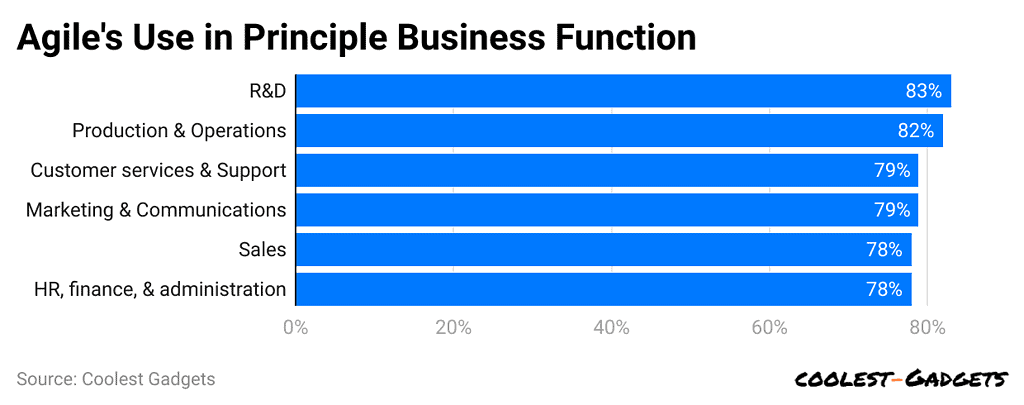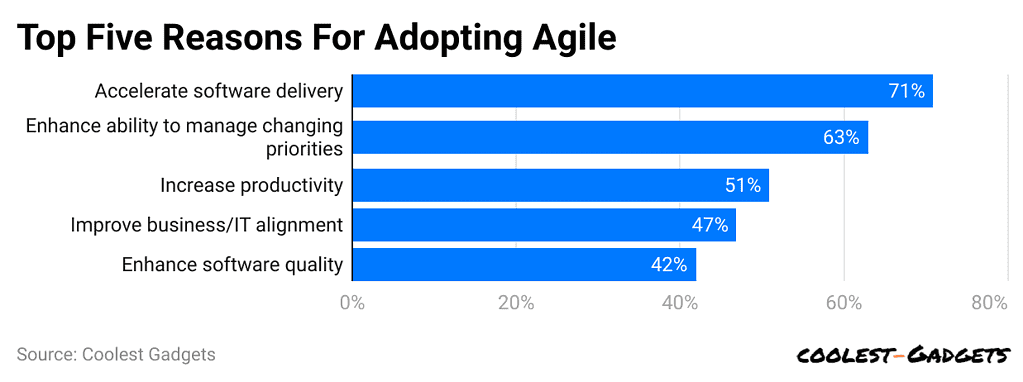Agile Statistics By Department, Methodology, Region-Wise Share and Industry

Updated · Feb 12, 2025


TABLE OF CONTENTS
- Introduction
- Editor’s Choice
- General Agile Statistics
- What Industries Are Agile?
- Popular Agile Principles Used in Business Functions
- Leading Reasons For Adopting Agile
- Widely Used Agile Metrics
- What is Agile?
- Agile Methodology By Industry
- Agile Statistics By Department
- Region-Wise Share of Agile Adoption
- Future Forecast of Agile By Industry
- Conclusion
Introduction
Agile Statistics: Agile has revolutionized project management, particularly in software development. By prioritizing flexibility, collaboration, and iteratively delivering working software, Agile empowers teams to adapt to changing requirements and deliver high-quality products. This approach fosters a culture of continuous improvement, customer satisfaction, and team empowerment. However, implementing Agile requires a cultural shift, strong communication skills, and a willingness to embrace uncertainty.
Despite these challenges, as shown by Agile Statistics, it remains a powerful tool for organizations seeking to thrive in today’s fast-paced and competitive landscape.
Editor’s Choice
- Agile Statistics reveal that profit rates based on agile projects are likely to increase the success rate by 64%.
- Agile transformation parameters are usually measured based on the following goals, as supported by companies worldwide: customer/ user satisfaction (59%), Business value (58%), business objectives achieved (50%), on-time delivery (48%), quality (48%), productivity (41%), and organization morale/ culture (41%).
- The leading reason for failing Agile projects is inexperience in handling Agile methods.
- 94% of companies have been practicing the agile approach for 1 to 5 years; 33% have already done so.
- Agile methodologies provide 40% improved project transparency in various departments in the companies.
- The technological industry has the highest rate of agile management. Agile Statistics revealed the rate at 27%.
- According to Zippia, agile has been implemented mainly in research and development, followed by production and operations, with 83% and 82%, respectively.
- Agile statistics show that accelerating software delivery is the leading reason for adopting Agile methodologies, contributing 71%.
- In 2024, approximately 80% of technology companies use Agile for software development, project management, and customer service.
- The adopted rate of the agile approach is as follows: hybrid marketing teams (53%), scrim (19%), Lean (4% business), Kanban (14%), and Scrumban (8%).
General Agile Statistics
- Agile Statistics reveal that profit rates based on agile projects are likely to increase the success rate by 64%.
- There are 53% of marketing teams using hybrid agile models.
- 88% of international business leaders say that agile can enhance life quality.
- 98% of businesses worldwide support Agile methodologies.
- Furthermore, implying Agile into operations has represented a 60% growth in revenue.
- On average, 9% of the businesses that implement Agile reported to fail.
- Agile Statistics show that companies that use agile methodologies are likely to improve productivity by 25%/
- The adopted rate of the agile approach is as follows: hybrid marketing teams (53%), scrim (19%), Lean (4% business), Kanban (14%), and Scrumban (8%).
- According to Zippia, 71% of the companies in the US have implemented Agile.
- The success rate for Agile projects is 1.5 times more than for waterfall projects.
- Nearly 80% of federal IT projects preferred to implement Agile.
- The leading reason for failing Agile projects is inexperience in handling Agile methods.
- Agile methodologies provide 40% improved project transparency in various departments in the companies.
- 94% of companies have been practicing the agile approach for 1 to 5 years; 33% have already done so.
- According to radixweb.com, 4% of businesses said they won’t implement Agile methodologies.
- Agile transformation parameters are usually measured based on the following goals, as supported by companies worldwide: customer/ user satisfaction (59%), Business value (58%), business objectives achieved (50%), on-time delivery (48%), quality (48%), productivity (41%), and organization morale/ culture (41%).
- 17% of the business leaders agreed to have achieved the collaborative and flexible Agile goals.
What Industries Are Agile?
| Industry | Percentage of use |
|
Technology |
27% |
| Financial Service |
18% |
|
Professional Services |
8% |
| Healthcare/ Pharma |
8% |
|
Government |
7% |
| Industrial Manufacturing |
5% |
|
Insurance |
5% |
| Telecoms |
4% |
|
Transportation |
3% |
| Energy |
3% |
|
Retail |
3% |
| Education |
2% |
|
Other |
7% |
(Source: runn.io)
The technological industry has the highest rate of agile management. Agile Statistics revealed the rate at 27%. With a major difference in the following industries, Financial services, and professional services stand second and third, contributing 18% and 8% respectively.
Popular Agile Principles Used in Business Functions

(Reference: zippia.com)
According to Zippia, agile has been implemented mainly in research and development, followed by production and operations, with 83% and 82%, respectively. In addition, other popular business operations where the agile framework is popular include customer service and support, marketing and communications, sales, HR, finance, and administration.
Leading Reasons For Adopting Agile

(Reference: zippia.com)
Agile statistics show that accelerating software delivery is the leading reason for adopting Agile methodologies, contributing 71%. Furthermore, enhances the ability to manage changing priorities and increases productivity by more than 50%. Other reasons why a significant number of users voted for it are improving business/IT alignment and enhancing software quality.
Widely Used Agile Metrics
Cycle time, velocity, and work in progress are the most commonly used agile metrics, with 66%, 61%, and 53%, respectively. On the other hand, the escaped defect rate blocked time and net promoter score have the fewest applications.
| Metrics | Share of Use |
| Cycle Time | 66% |
| Velocity | 61% |
| Work in Progress (WIP) | 53% |
| Sprint Burndown | 47% |
| Happiness Metric | 42% |
| Cumulative Flow | 40% |
| Lead Time | 37% |
| Throughput | 37% |
| Escaped defect rate | 16% |
| Blocked time | 13% |
| Net Promoter Score | 11% |
| Other | 3% |
(Source: parabol.co)
What is Agile?
Agile is a project management and product development methodology focused on flexibility, collaboration, and customer feedback. Instead of following a rigid plan, Agile promotes iterative work cycles, known as sprints, where teams develop, test, and improve a product continuously. Agile’s adaptability makes it suitable for rapidly changing industries, especially those driven by technology and customer needs.
Agile’s core values—individuals and interactions, working products, customer collaboration, and responsiveness to change—have led to its widespread adoption. Initially popular in software development, Agile is now used in various industries and departments, from marketing and HR to sales and security.
Agile Methodology By Industry
#1. Technology
- Agile is fundamental to the technology industry, where software development needs are constantly changing.
- In 2024, approximately 80% of technology companies use Agile for software development, project management, and customer service.
- The industry invests around USD 1.5 billion annually in Agile training and resources.
- Agile’s iterative approach has proven effective for tech companies, resulting in 25% faster project completion rates and improving customer satisfaction by up to 30%.
#2. Finance
- Agile adoption in finance is at 60%, focusing on enhancing customer experiences, cybersecurity, and compliance.
- Banks and financial institutions use Agile to quickly develop apps, manage digital transformation, and adapt to regulatory changes.
- Agile’s adoption has increased productivity in finance by 20%, with Agile investments reaching USD 1 billion in 2024.
- As the industry faces increased competition, Agile’s role in maintaining efficiency and innovation is expected to grow by 10% annually.
#3. Healthcare
- In healthcare, the adoption of Agile is at 50%, especially in software development and data management for patient care systems.
- Hospitals and medical software companies use Agile to improve efficiency and flexibility.
- Agile Statistics showcase that, with Agile, healthcare organizations have reduced project completion times by 15% and improved adaptability to new healthcare regulations by 25%.
- Spending on Agile methodology in healthcare is estimated at USD 800 million in 2024 and is forecasted to grow 12% annually.
#4. Government
- Agile Statistics show that government agencies have adopted Agile in about 45% of projects, primarily in technology, security, and project management.
- Agile helps governments improve service delivery, compliance, and data management. Agile projects in government have improved efficiency by 18% and increased citizen satisfaction by 10%.
- Investments in Agile within government agencies are estimated at USD 700 million in 2024, with a 10% growth rate projected over the next five years.
#5. Manufacturing
- Agile is gaining ground in manufacturing, with a 40% adoption rate, mostly in software development for automation, product design, and supply chain management.
- By applying Agile, manufacturers have achieved a 15% increase in productivity and faster response times to market demands.
- Agile adoption is valued at USD 500 million annually and is expected to grow 15% annually as manufacturers pursue automation and real-time data analytics.
#6. Insurance
- In insurance, Agile adoption stands at 55%, with applications in product development, claims processing, and customer service.
- Agile allows insurance companies to innovate rapidly and respond to regulatory changes.
- With Agile, insurers report a 20% reduction in time-to-market for new products.
- Spending on Agile practices is estimated at USD 600 million annually in 2024, with expected growth of 8% each year.
#7. Telecoms
- About 65% of telecom companies use Agile, especially for network upgrades, software development, and customer support.
- Agile’s fast-paced, flexible structure has led to a 20% increase in service delivery speed.
- In 2024, Agile investments in telecom are approximately USD 900 million, projected to grow 10% per year as 5G and IoT drive rapid technological advancements.
#8. Transportation
- The transportation industry has a 40% Agile adoption rate, primarily in logistics and software development.
- By using Agile, transportation companies have improved operational efficiency by 15% and reduced project delays by 10%.
- Spending on Agile practices in transportation is valued at USD 500 million in 2024, with an anticipated annual growth of 12%.
#9. Energy
- The energy sector is adopting Agile at a rate of 35%, especially in software development, project management, and compliance.
- Agile has improved project completion times by 18% in the energy sector.
- Agile spending in energy is estimated at USD 400 million annually, with projected growth of 8% as companies focus on digital transformation and sustainability.
#10. Retail
- In retail, Agile is used in product development, marketing, and e-commerce, with a 50% adoption rate.
- Agile methodologies have improved customer satisfaction by 22% and shortened product launch times by 15%.
- Retail companies invested around USD 600 million in Agile practices in 2024, and adoption is expected to grow by 10% annually as e-commerce continues to expand.
#11. Education
- Education has a 30% adoption rate of Agile, mainly in software development, HR, and curriculum planning.
- By using Agile, educational institutions report a 10% improvement in program effectiveness and a 15% reduction in project completion times.
- Spending on Agile in education is estimated at USD 300 million in 2024, with an annual growth projection of 8%.
Agile Statistics By Department
- Software Development: Agile is standard, with an adoption rate of 85% in software development departments. Companies are investing over USD 3 billion in Agile for development to keep up with innovation.
- Marketing and Sales: Agile adoption in marketing and sales is at 50%. It is used to improve customer engagement and time to market for products. Agile helps teams quickly adapt campaigns, resulting in a 20% increase in ROI across industries.
- Security: Agile is less common in security but growing, with a 30% adoption rate, mainly in industries like technology and finance. By using Agile, security teams respond 25% faster to threats.
- Human Resources (HR): Agile adoption in HR is at 35%, with HR teams using it for talent acquisition, onboarding, and training. Agile HR processes have improved employee engagement by 15%.
- North America: North America leads in Agile adoption, with a 50% share across industries. Agile is widely used in software development, finance, and technology. The region invests USD 3 billion annually in Agile practices.
- Europe: Europe accounts for 30% of Agile adoption, with finance, government, and manufacturing leading the way. Agile is essential for complying with regulatory requirements, and spending is around USD 2 billion annually.
- Asia-Pacific: The Asia-Pacific region has a 15% share, with high adoption in telecom and manufacturing. Agile is growing quickly here due to digital transformation in sectors like technology and finance. Agile investments in this region are estimated at USD 1.2 billion.
- Latin America and Africa: Latin America and Africa together make up about 5% of global Agile adoption. Adoption is highest in technology and government, with a combined spending of around USD 400 million annually.
You May Also Like To Read
- ChatGPT 4 Statistics
- Slack Statistics
- SaaS Statistics
- Microsoft Teams Statistics
- Facial Recognition Statistics
- GitHub Statistics
Future Forecast of Agile By Industry
Agile adoption is expected to grow steadily across all industries. By 2027, Agile is projected to be used in over 70% of organizations worldwide. Industries like healthcare and government will see significant growth as they adapt to digital demands. Agile’s value will reach over USD 12 billion globally by 2027, with new regions and sectors contributing to its expansion. The methodology’s future looks promising as industries continue to invest in Agile for flexibility, faster delivery, and improved customer satisfaction.
In 2024, Agile methodologies remain popular across industries, with certain frameworks dominating the global landscape. Agile’s adaptability, speed, and focus on customer feedback have driven its adoption worldwide. Here is a breakdown of the most used Agile methodologies globally in 2025, highlighting their popularity by percentage share.
#1. Scrum
- Global Share: Scrum leads among Agile methodologies, with an estimated 58% share of Agile practices worldwide in 2024.
- Usage: Scrum’s structured approach to sprints and regular feedback loops makes it a favorite in software development and technology-driven projects. Industries such as finance, healthcare, and retail also use Scrum for project management and product development.
- Financial Impact: The global market for Scrum-related tools, training, and certifications is projected to reach USD 3.5 billion in 2024, driven by its widespread adoption across industries.
#2. Kanban
- Global Share: Kanban holds approximately 21% of the Agile market share, making it the second most popular methodology.
- Usage: Kanban’s visual task boards help teams manage workflows in real time, making it popular in sectors like manufacturing, telecom, and logistics. Kanban’s flexibility appeals to teams focusing on continuous delivery and efficiency, particularly in high-demand environments.
- Financial Impact: The market for Kanban software and tools is valued at USD 1.5 billion in 2024, and it is expected to grow as demand for real-time task management increases.
#3. ScrumBan
- Global Share: ScrumBan, a combination of Scrum and Kanban, accounts for about 10% of Agile usage worldwide.
- Usage: ScrumBan is widely used by teams that need both the structured approach of Scrum and the flexibility of Kanban. Industries such as healthcare, finance, and energy favor ScrumBan for hybrid project management needs.
- Financial Impact: With the rising need for adaptable project management frameworks, the ScrumBan market is expected to reach USD 700 million in 2024.
#4. Extreme Programming (XP)
- Global Share: Extreme Programming (XP) has a 6% share in Agile practices globally.
- Usage: XP is primarily used in software development teams focused on high-quality code and frequent releases. It is popular in tech companies, startups, and organizations where customer feedback plays a critical role.
- Financial Impact: The market for XP tools and training is valued at USD 400 million in 2024, with growth expected as more tech companies adopt Agile.
#5. Lean Development
- Global Share: Lean Development holds a 3% share in Agile methodology adoption.
- Usage: Lean is commonly adopted in manufacturing, logistics, and retail industries, where waste reduction and efficiency are key. Lean principles focus on delivering value by minimizing unnecessary processes, making it a top choice for production-heavy sectors.
- Financial Impact: The Lean market, including Lean-specific tools and consulting, is valued at approximately USD 300 million in 2024.
#6. Feature-Driven Development (FDD)
- Global Share: FDD holds around 2% of Agile’s global market share.
- Usage: FDD is typically used in large software projects that require a structured approach. It’s common in sectors such as finance and telecom, where projects benefit from feature-based development.
- Financial Impact: The FDD market is estimated at USD 200 million in 2024, with limited but steady growth in specific industries.
Conclusion
The demand for Agile methodologies is expected to grow as industries continue to prioritize flexibility, customer feedback, and faster delivery. By 2026, Agile methodologies could account for 80% of project management approaches globally, with total spending on Agile reaching USD 12 billion. Scrum, Kanban, and hybrid frameworks like ScrumBan will likely remain dominant, with new tools and software supporting Agile’s expansion into new sectors.
Sources

Saisuman is a talented content writer with a keen interest in mobile tech, new gadgets, law, and science. She writes articles for websites and newsletters, conducting thorough research for medical professionals. Fluent in five languages, her love for reading and languages led her to a writing career. With a Master’s in Business Administration focusing on Human Resources, Saisuman has worked in HR and with a French international company. In her free time, she enjoys traveling and singing classical songs. At Coolest Gadgets, Saisuman reviews gadgets and analyzes their statistics, making complex information easy for readers to understand.











